COVID-19 day 186: 📈 73,783 cases; 1,242 deaths (US): 24 July 2020
We've passed the 4 million mark; in-person RNC now shuttered; $600 unemployment supplement, federal eviction protection ending; 31 states are on the quarantine list for travelers to NY, NJ and CT
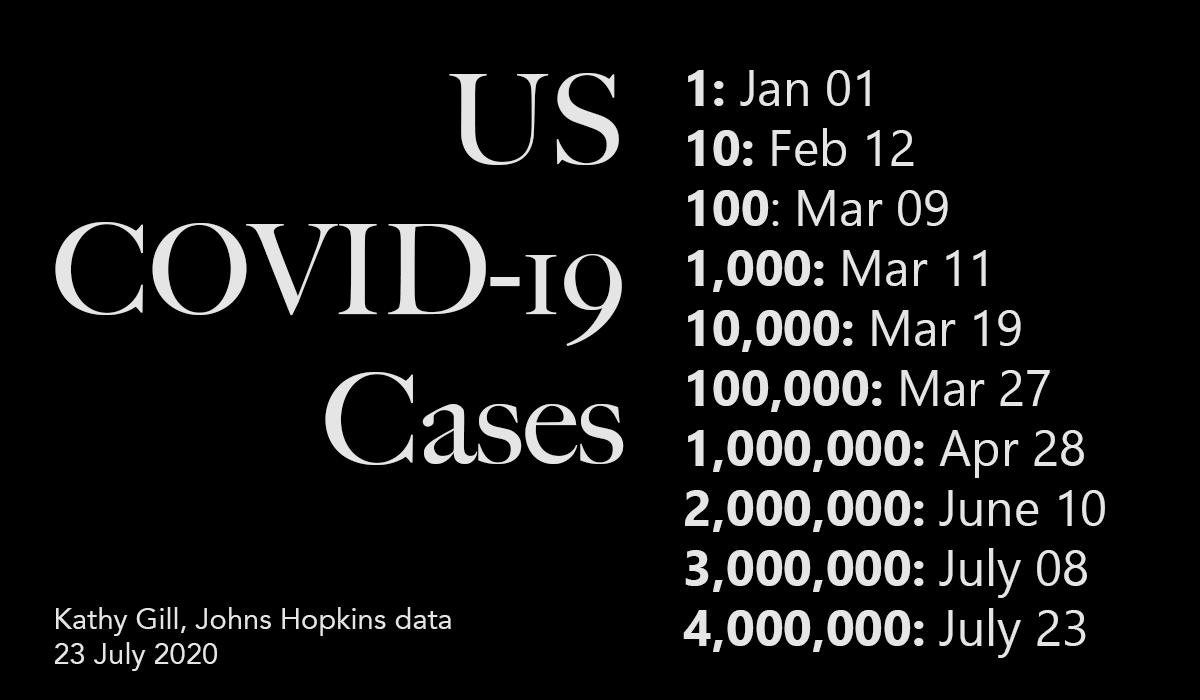
It’s day 186 since the first case of coronavirus disease was announced in the United States. I’ve been on hiatus due to health issues this week (not COVID!). Data from the missing three days will (eventually) be accessible on WiredPen.
We crossed the 4 million case mark on Thursday; it took 15 days to add another million cases. The first million, 99 days (Johns Hopkins and state data).
Sections (no jump links, sorry!)
1, One big thing; 2, Key metrics; 3, Recommendations; 4, Politics, economics & COVID; 5, Case counts and resources
⓵ One big thing - red zones
Danger, Will Robinson! Positivity rates and per capita case rates.
When a state consistently has a positivity test rate of more than than 5% (WHO guideline), it is unlikely that the state is testing broadly enough to find all cases. (The US task force uses 10%.) The higher the positivity rate, the more likely a state is only identifying the sickest people. However, like most COVID-19 measurements, it’s the contextual trend that is important.
More populous states will, all things being equal, have more cases. There were headlines about California cases this week. And although the state clearly has hot spots, based on per capita data it is not the “hottest” state in the current outbreak. That would be Louisiana (2,231 cases/100,000) and Arizona (2,147 cases/100,000). Both exceed the New York state rate of 2,110. The US rate is 1,242.
These trend data from Johns Hopkins illustrate variability between hot spots. How valid is Arizona’s declining number of cases given its high positivity rate and low test rate per 1,000 people? Is it more risky to live there than Louisiana?
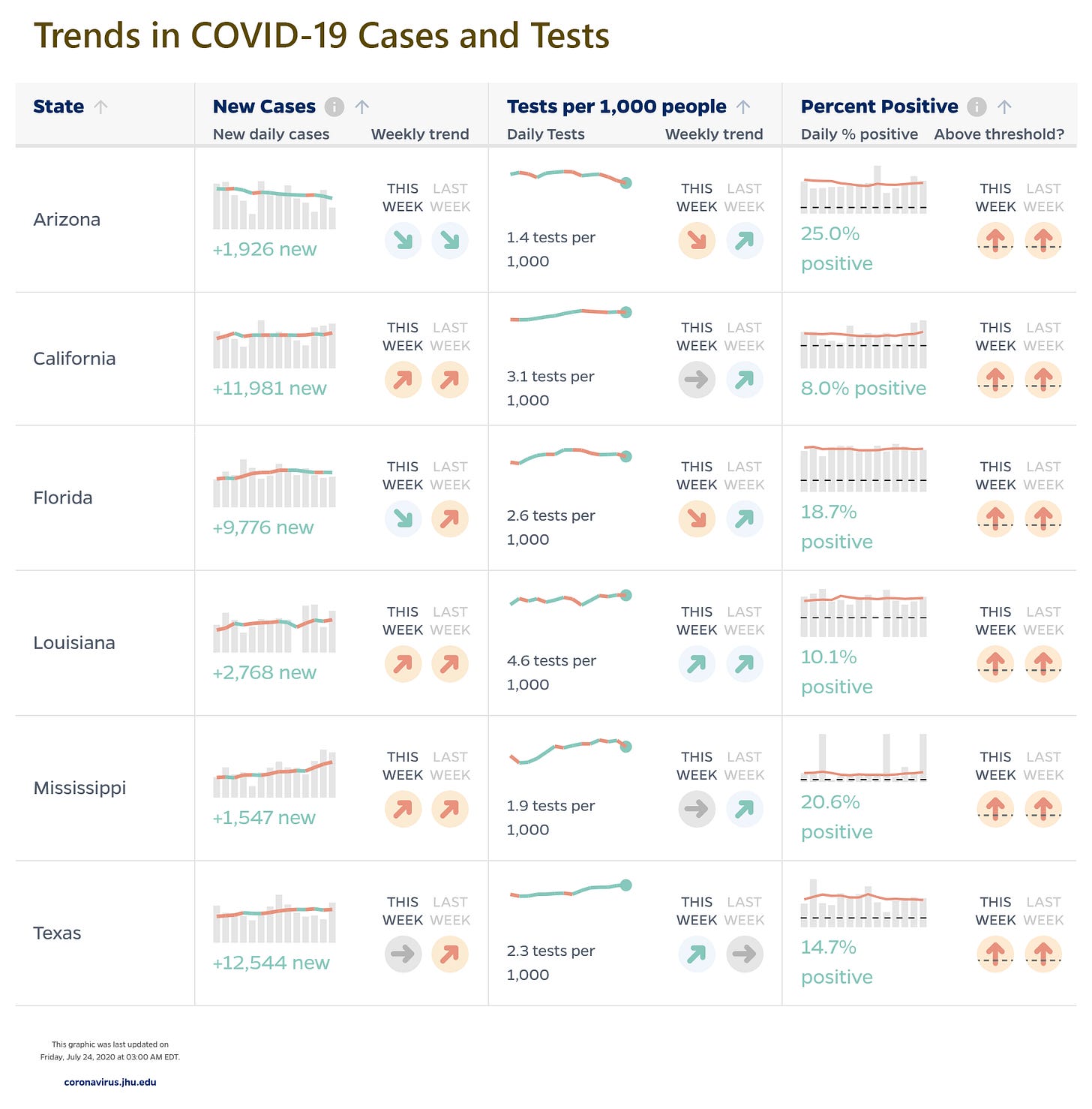
What if I told you that Louisiana ranks third of the 50 states in per capita testing, and Arizona, 35th? How might that change your assessment of their relative risk?
Trends are important, but they need to be combined with other data to assess risk. Why are case numbers going down in Arizona, where 1-in-4 tests are positive? Has the disease truly peaked? Only time will tell.
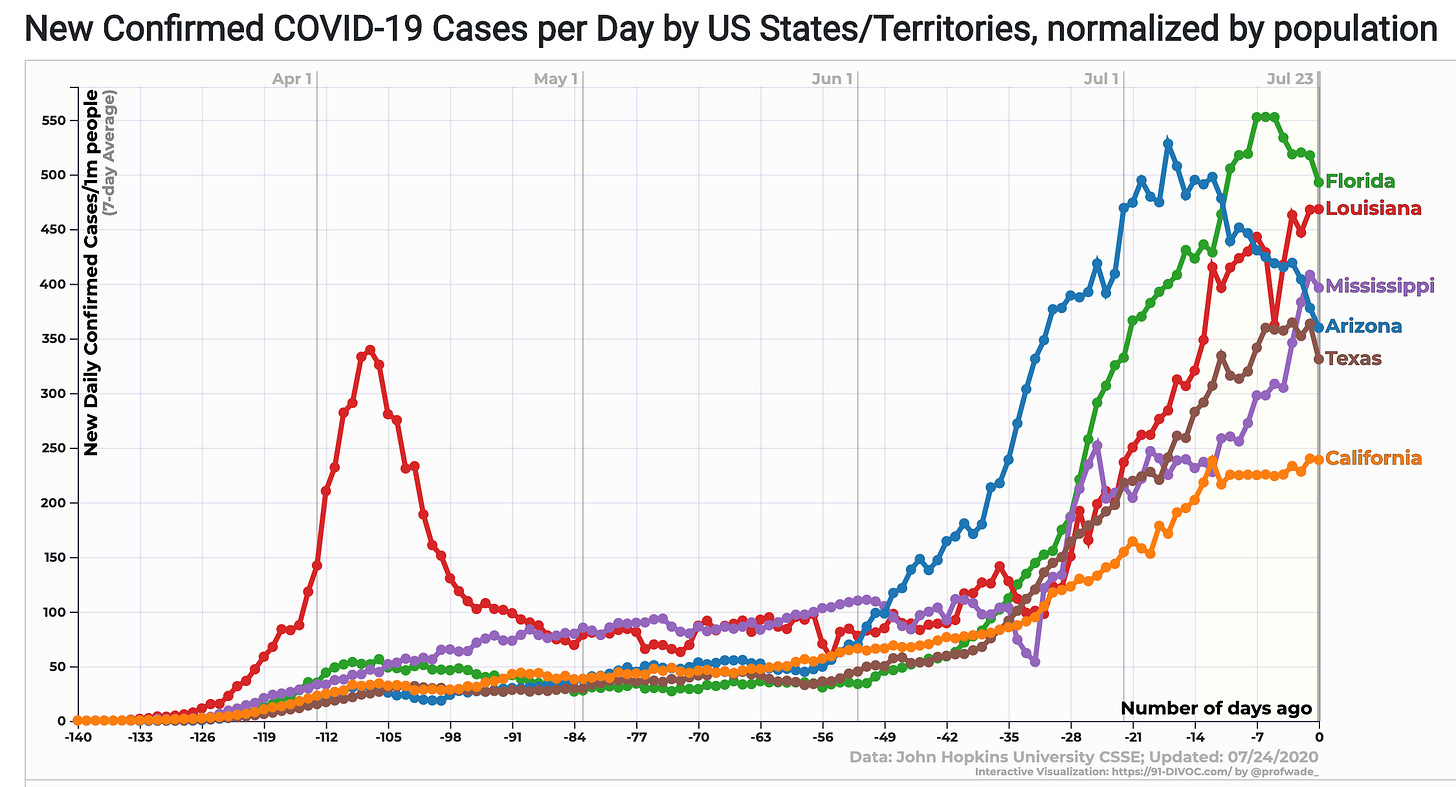
⓶ Key metrics
🦠 Friday, Johns Hopkins reported 4,112,531 (73,783 new) cases and 145,546 (1,242 new) deaths, an increase of 1.83% and 0.83%, respectively, since Thursday. A week ago, the daily numbers increased by 2.00% and 0.66%, respectively.
Today
- seven-day average: 67,047 cases and 899 deaths
- 3.54% cases leading to death
- case rate, 1,242.45 per 100,000; death rate, 43.97 per 100,000One week ago
- seven-day average: 66,221 cases and 747 deaths
- 3.82% cases leading to death
- case rate, 1,102.02 per 100,000; death rate, 42.07 per 100,000
Note: the seven-day average is important because dailies vary due to factors other than actual case numbers, particularly over a weekend.
⓷ Recommendations
🤓 Recommended reading
Biologically, a vaccine against the COVID-19 virus is unlikely to offer complete protection. Logistically, manufacturers will have to make hundreds of millions of doses while relying, perhaps, on technology never before used in vaccines and competing for basic supplies such as glass vials. Then the federal government will have to allocate doses, perhaps through a patchwork of state and local health departments with no existing infrastructure for vaccinating adults at scale. The Centers for Disease Control and Prevention, which has led vaccine distribution efforts in the past, has been strikingly absent in discussions so far—a worrying sign that the leadership failures that have characterized the American pandemic could also hamper this process. To complicate it all, 20 percent of Americans already say they will refuse to get a COVID-19 vaccine, and with another 31 percent unsure, reaching herd immunity could be that much more difficult….
It is awful to contemplate the suffering still ahead. It is easier to think about the promise of a vaccine.
A Vaccine Reality Check. The Atlantic, 24 July 2020.
🔬 Research and medical news
A New York-based study at the height of the pandemic suggests that “perinatal SARS-CoV-2 transmission is unlikely and allowing newborns to room-in and breastfeed is safe, with appropriate precautions.”
Management of mother–newborn dyads in the COVID-19 era. The Lancet, 23 July 2020.
The first statewide random sample study in the U.S. took place in Indiana.
Random testing in Indiana shows COVID-19 is 6 times deadlier than flu, and 2.8% of the state has been infected. The Conversation, 21 July 2020.
⓸ Politics, economics and COVID-19
🆘 The coronavirus bill Congress passed in March included a $600 federal supplement to weekly state unemployment benefits. For many Americans, that ends this week because the CARES Act requires the subsidy to end on or before July 31. And it is unlikely that Congress will act soon. Federal eviction protections are also set to expire.
📣The list of states whose residents must quarantine should they want to visit New York, New Jersey or Connecticut has grown to 31. The list is based upon a seven-day rolling average of (1) positive cases that exceed 10 per 100,000 residents or (2) positive tests greater than 10%.
The District of Columbia announced a similar measure on Friday for DC residents or travelers involved in “non-essesntial” travel from states with a seven-day rolling average of positive cases that exceeds 10 per 100,000 residents.
❌ This weekend, Sinclair Broadcasting group is running an interview on its local TV network with “Judy Mikovits, the medical researcher featured in the discredited ‘Plandemic’ video that went viral earlier this year and which was banned from platforms such as Facebook and YouTube.”
It appears on America This Week, hosted by Eric Bolling.
During the interview Mikovitz told Bolling that Fauci had over the past decade “manufactured” and shipped coronaviruses to Wuhan, China, which became the original epicenter of the current outbreak. Bolling noted that this was a “hefty claim,” but did not meaningfully challenge Mikovits and allowed her to continue making her case.
Sinclair, which paid a record FCC fine in May, is the country’s second largest TV station broadcaster and can reach 4-in-10 American households. The episode is available for streaming on Sinclair TV station websites. Here’s a list of Sinclair stations by state.

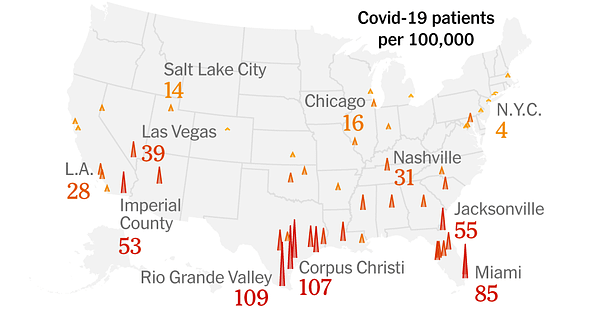
✅ In case you missed it, the GOP finally threw in the towel on its plans to hold a “all is normal” four-night Republican National Convention. This is after President Trump moved the event from North Carolina (1,039 cases per 100,000) to Florida (1,873 cases per 100,000).
🦠The virus has long legs.
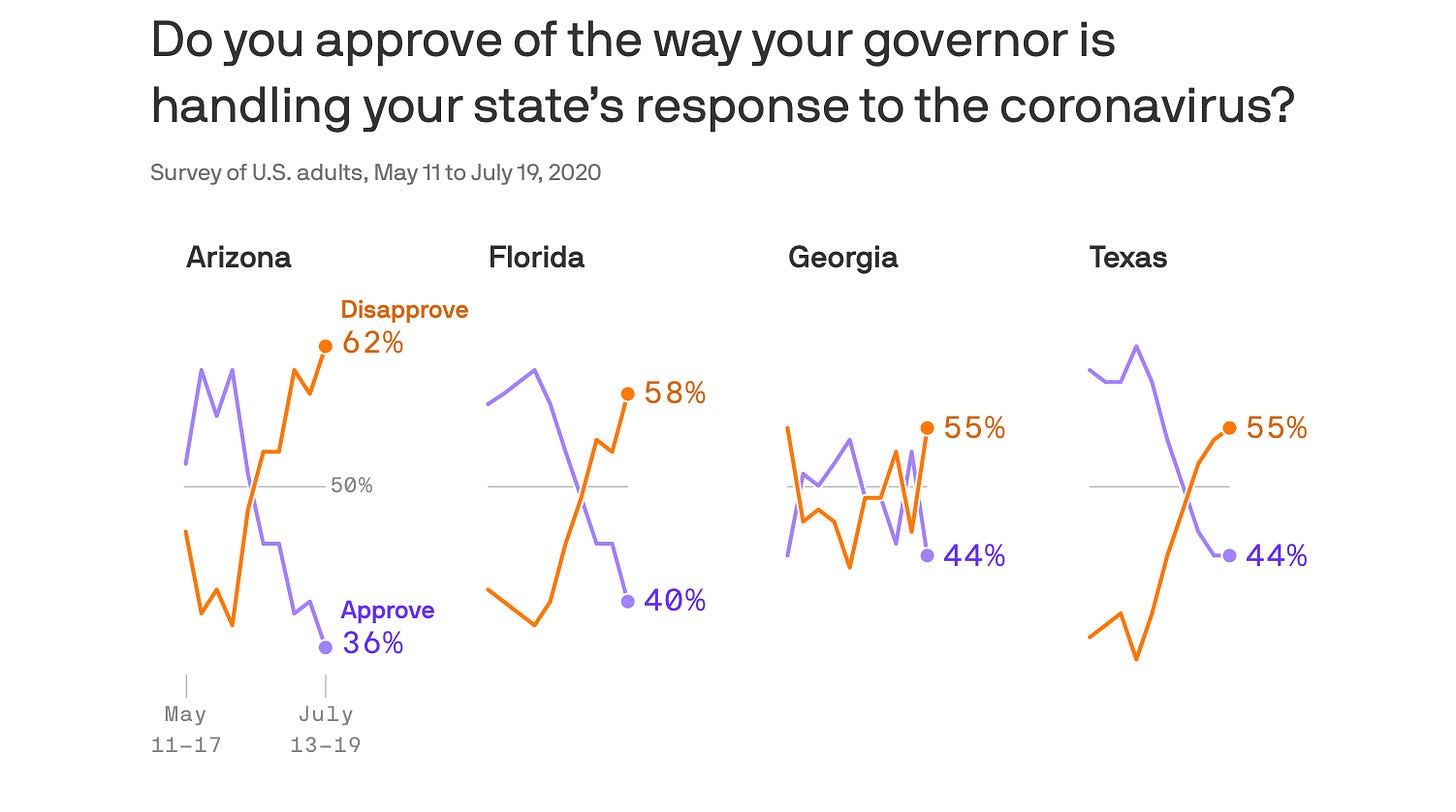
⓹ Case counts and resources
CDC, Johns Hopkins, states, WHO
🇺🇸 24 July
CDC: 4,024,492 (72,219 new) cases and 143,868 (1,113 new) deaths
Johns Hopkins*: 4,112,531 (73,783 new) cases and 145,546 (1,242 new) deaths
State data*: 4,092,928 (75,193 new) cases and 137,655 (1,178 new) deaths
KS reports only M-W-F; CT and RI report only M-FWHO Situation report, 185
3 938 094 cases (69 641 new) with 142 553 deaths (1 074 new)
🌎 24 July
Johns Hopkins interactive dashboard (11.00 pm Pacific)
Global cases: 15,736,499 (225,342 new)
Total deaths: 639,652 (6,256 new)
Global: 15 296 926 cases (284 196 new) with 628 903 deaths (9 753 new)
The Americas: 8 121 700 cases (173 187 new) with 325 625 deaths (7 663 new)
* Johns Hopkins data, ~11.00 pm Pacific.
State data include DC, Guam, the Northern Mariana Islands, Puerto Rico and the US Virgin Islands
The virus was not created in a lab and the weight of evidence is it was not released intentionally. Although early reports tied the outbreak to a market in Wuhan, China, analyses of genomic data in January suggested that the virus might have developed elsewhere.
Resources
👓 See COVID-19 resource collection at WiredPen.
📝 Subscribe to Kathy’s COVID-19 Memo :: COVID-19 Memo archives
🦠 COVID-19 @ WiredPen.com
📊 Visualizations: US, World
🌐 Global news (at WiredPen)



